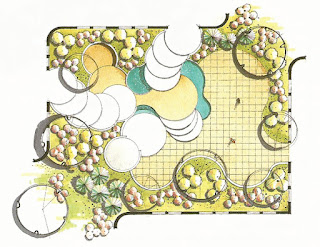Basic Elements of landscape Design
If you're familiar with the fundamentals of landscape design, you'll find it easier to define your landscape project and find the landscaping designers near you to help you design, install, and maintain it.
Landscape design, in essence, blends horticultural science, artistic composition, and spatial organization to produce appealing and practical outdoor areas.
It employs design features and principles to define, connect, and aesthetically enhance areas. Understanding these factors is an excellent starting point.
Color
Color is a simple and necessary aspect in our daily lives, yet it is extremely complex in landscaping. Color has the ability to communicate a person's or designer's personal taste.
Warm colors such as reds, oranges, and yellows tend to move closer to the spectator, whilst cooler tones such as blues, violets, and greens tend to retreat into the background. Warm colors have a greater influence on the eye than cool colors. Warm and cold color schemes have varied visual effects on the landscape.
Color is a significant aspect in both softscape and hardscape design. The foliage and inflorescence color creates a pleasant atmosphere. As a result, color composition must be considered in connection with the seasons at various levels and presented to make a harmonious design.
Line
Actual lines can exist alongside perceived lines. Lines are associated with the movement or flow of the eye. They can be made vertically, horizontally, or curved. Vertical lines are generated in the landscape layout based on the height of the species of trees, shrubs, or groundcover.
The landscape plan is used to produce horizontal and curved lines. As a result, the lines utilized in the formation of the landscape design influence the arrangement and order of the plants.
Perceived lines are produced based on a series to provide the impression that a line is inferred. Following plant arrangement, the behavior of the species might determine inferred lines in design.
Scale
Relativity is at the heart of scale, a landscaping architect near you will tell you . The size of an object or things in relation to their surroundings is referred to as scale. Because everything is so subjective, it boils down to "does this seem right?" Scale and proportion must be considered in their context.
The landscape design plants should have a feeling of scale or individual components in relation to groupings. Keep in mind that the size of the trees and bushes you plant should compliment the building that surrounds them.
A five-foot wall, for example, would appear out of place next to a house. The photo should be framed appropriately. Following a sense of size and proportion may help the design to feel more cohesive and harmonious.
Texture
Landscape design uses texture in a subtle but crucial way. The texture of a leaf, the coarseness or fineness of a bark, or even the weight of the leaves all contribute to the overall aspect of the design. Leaves, twigs, branches, bark, and even flowers all have different textures.
Contrasting textures are vital in creating interest in a scene.The textural variation is visible due to the shape and surface of the plant's leaves. So, if texture is divided into coarse, medium, and fine, landscape design should attempt to establish a balance of all three types in varied locations by using texture.
Form
Line and form are inextricably linked. In a design, line is generated by the contour or edge of the plant material or items, whereas form is more expensive. The shape of a plant is referred to as its form.
Plants are placed according to their habit, which might be linear, erect, spreading, drooping, and so on. Plants can vary their look depending on whether they are planted in groups or individually.
Three-dimensional items like trees and plants are related to form. As a result, design composition can be made up of grouped or individual shapes of diverse plant species to help your design come together.






Comments
Post a Comment